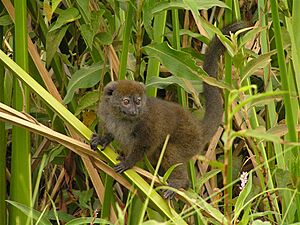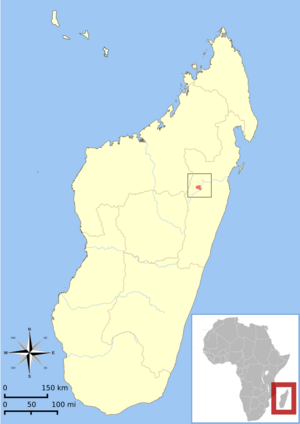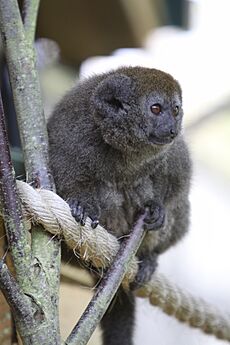Lac Alaotra bamboo lemur facts for kids
Quick facts for kids Lac Alaotra bamboo lemur |
|
|---|---|
 |
|
| Lac Alaotra bamboo lemur near Lake Alaotra | |
| Conservation status | |
| Scientific classification | |
 |
|
| Distribution of H. alaotrensis |
The Lac Alaotra bamboo lemur (Hapalemur alaotrensis) is also known by many other names. These include the Lac Alaotra gentle lemur or the Alaotra reed lemur. Locals in Madagascar call it the bandro. This special lemur lives only in the reed beds around Lac Alaotra in northeast Madagascar.
It is about 40 cm (16 in) long, with a tail about the same length. Its fur is a brownish-gray color. This lemur is unique because it is the only bamboo lemur that lives in and eats papyrus reeds and other grasses. Sadly, its population is shrinking fast. The International Union for Conservation of Nature says it is "critically endangered".
Contents
What is the Lac Alaotra Bamboo Lemur?
Scientists sometimes disagree about how to classify the bandro. Some think it is a separate species. Others believe it is a subspecies of the eastern lesser bamboo lemur (Hapalemur griseus).
Genetic studies have shown that the two groups are very similar. This means they might be subspecies rather than completely different species. More research is needed to decide for sure.
What Does the Lac Alaotra Bamboo Lemur Look Like?
The Lac Alaotra bamboo lemur has a body and tail that are both about 40 centimetres (16 in) long. It weighs between 1.1–1.4 kilograms (2.4–3.1 lb). Male lemurs are usually a little bigger than females.
Its fur is thick and soft. It is gray-brown on its back. The fur on its face and chest is a lighter gray. Its head and neck have a chestnut brown color.
What Does the Lac Alaotra Bamboo Lemur Eat?
This lemur is the only primate that has adapted to live in papyrus reeds. Unlike other bamboo lemurs, the Lac Alaotra bamboo lemur does not eat bamboo.
Instead, it eats the stems of papyrus reeds. It also eats shoots from a grass called Phragmites communis. Two other types of grasses, Echinochloa crus-galli and Leersia hexandra, are also part of its diet.
Why is the Lac Alaotra Bamboo Lemur Endangered?
The number of Lac Alaotra bamboo lemurs is going down. This is because their home around the lake is being destroyed. People are turning the marshland into rice fields.
Other dangers include people burning the marshland. This is often done for fishing or to create grazing areas for cattle. This burning harms the lemurs and stops the marsh from growing back.
Hunting is also a big problem. Local people hunt the lemurs for food. Some lemurs are also caught and sold as pets. These activities have greatly reduced the number of Hapalemur alaotrensis.
Conservation Efforts
The International Union for Conservation of Nature has listed this lemur as "critically endangered". This means it is at a very high risk of becoming extinct.
However, there is hope! A new protected area was created around Lac Alaotra in 2007. This area covers about 42,478 hectares and helps protect the lemurs. The Durrell Wildlife Conservation Trust also has a program to help save the Lac Alaotra bamboo lemur. Some zoos are also working to breed these lemurs in captivity. This helps ensure the species survives.



